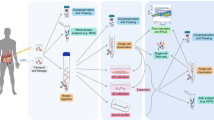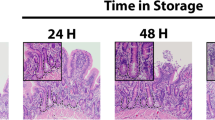Abstract
Intestinal stem cells (ISCs) are responsible for renewal of the epithelium both during normal homeostasis and following injury. As such, they have significant therapeutic potential. However, whether ISCs can survive tissue storage is unknown. We hypothesize that, although the majority of epithelial cells might die, ISCs would remain viable for at least 24 h at 4 °C. To explore this hypothesis, jejuna of C57Bl6/J or Lgr5-LacZ mice were removed and either processed immediately or placed in phosphate-buffered saline at 4 °C. Delayed isolation of epithelium was performed after 24, 30, or 48 h storage. At the light microscope level, despite extensive apoptosis of villus epithelial cells, small intestinal crypts remained morphologically intact for 30 h and ISCs were identifiable via Lgr5-LacZ positivity. Electron microscopy showed that ISCs retained high integrity for 24 h. When assessed by flow cytometry, ISCs were more resistant to degeneration than the rest of the epithelium, including neighboring Paneth cells, with higher viability across all time points. Cultured isolated crypts showed no loss of capacity to form complex enteroids after 24 h tissue storage, with efficiencies after 7 days of culture remaining above 80 %. By 30 h storage, efficiencies declined but budding capability was retained. We conclude that, with delay in isolation, ISCs remain viable and retain their proliferative capacity. In contrast, the remainder of the epithelium, including the Paneth cells, exhibits degeneration and programmed cell death. If these findings are recapitulated in human tissue, storage at 4 °C might offer a valuable temporal window for the harvesting of crypts or ISCs for therapeutic application.






Similar content being viewed by others
References
Avansino JR, Chen DC, Hoagland VD, Woolman JD, Haigh WG, Stelzner M (2005) Treatment of bile acid malabsorption using ileal stem cell transplantation. J Am Coll Surg 201:710–720
Barker N, van Es JH, Kuipers J, Kujala P, van den Born M, Cozijnsen M, Haegebarth A, Korving J, Begthel H, Peters PJ, Clevers H (2007) Identification of stem cells in small intestine and colon by marker gene Lgr5. Nature 449:1003–1007
Barker N, van Oudenaarden A, Clevers H (2012) Identifying the stem cell of the intestinal crypt: strategies and pitfalls. Cell Stem Cell 11:452–460
Bitar KN, Raghavan S (2012) Intestinal tissue engineering: current concepts and future vision of regenerative medicine in the gut. Neurogastroenterol Motil 24:7–19
Carlone DL, Breault DT (2012) Tales from the crypt: the expanding role of slow cycling intestinal stem cells. Cell Stem Cell 10:2–4
Cheng H, Leblond CP (1974) Origin, differentiation and renewal of the four main epithelial cell types in the mouse small intestine. V. Unitarian theory of the origin of the four epithelial cell types. Am J Anat 141:537–562
Dehmer JJ, Garrison AP, Speck KE, Dekaney CM, Van Landeghem L, Sun X, Henning SJ, Helmrath MA (2011) Expansion of intestinal epithelial stem cells during murine development. PLoS One 6:e27070
Dekaney CM, Fong JJ, Rigby RJ, Lund PK, Henning SJ, Helmrath MA (2007) Expansion of intestinal stem cells associated with long-term adaptation following ileocecal resection in mice. Am J Physiol Gastrointest Liver Physiol 293:G1013–G1022
Dekaney CM, Gulati AS, Garrison AP, Helmrath MA, Henning SJ (2009) Regeneration of intestinal stem/progenitor cells following doxorubicin treatment of mice. Am J Physiol Gastrointest Liver Physiol 297:G461–G470
Erker L, Azuma H, Lee AY, Guo C, Orloff S, Eaton L, Benedetti E, Jensen B, Finegold M, Willenbring H, Grompe M (2010) Therapeutic liver reconstitution with murine cells isolated long after death. Gastroenterology 139:1019–1029
Formeister EJ, Sionas AL, Lorance DK, Barkley CL, Lee GH, Magness ST (2009) Distinct sox9 levels differentially mark stem/progenitor populations and enteroendocrine cells of the small intestine epithelium. Am J Physiol Gastrointest Liver Physiol 296:G1108–G1118
Fuller MK, Faulk DM, Sundaram N, Shroyer NF, Henning SJ, Helmrath MA (2012) Intestinal crypts reproducibly expand in culture. J Surg Res 178:48–54
Garrison AP, Helmrath MA, Dekaney CM (2009) Intestinal stem cells. J Pediatr Gastroenterol Nutr 49:2–7
Grikscheit TC, Siddique A, Ochoa ER, Srinivasan A, Alsberg E, Hodin RA, Vacanti JP (2004) Tissue-engineered small intestine improves recovery after massive small bowel resection. Ann Surg 240:748–754
Gupta A, Dixit A, Sales KM, Winslet MC, Seifalian AM (2006) Tissue engineering of small intestine—current status. Biomacromolecules 7:2701–2709
Itoh H, Yagi M, Hasebe K, Fushida S, Tani T, Hashimoto T, Shimizu K, Miwa K (2002) Regeneration of small intestinal mucosa after acute ischemia-reperfusion injury. Dig Dis Sci 47:2704–2710
King SL, Dekaney CM (2013) Small intestinal stem cells. Curr Opin Gastroenterol 29:140–145
Lahar N, Lei NY, Wang J, Jabaji Z, Tung SC, Joshi V, Lewis M, Stelzner M, Martin MG, Dunn JC (2011) Intestinal subepithelial myofibroblasts support in vitro and in vivo growth of human small intestinal epithelium. PLoS One 6:e26898
Levin DE, Grikscheit TC (2012) Tissue-engineering of the gastrointestinal tract. Curr Opin Pediatr 24:365–370
Li L, Clevers H (2010) Coexistence of quiescent and active adult stem cells in mammals. Science 327:542–545
Liu PI, Ogawa M, Crook L, Ochia R, Upshur JK (1978) Proliferative function of cadaveric bone marrow cells. Am J Hematol 5:145–150
Lund PK (2012) Fixing the breaks in intestinal stem cells after radiation: a matter of DNA damage and death or DNA repair and regeneration. Gastroenterology 143:1144–1147
Montgomery RK, Breault DT (2008) Small intestinal stem cell markers. J Anat 213:52–58
Montgomery RK, Carlone DL, Richmond CA, Farilla L, Kranendonk MEG, Henderson DE, Baffour-Awuah NY, Ambruzs DM, Fogli LK, Algra S, Breault DT (2011) Mouse telomerase reverse transcriptase (mtert) expression marks slowly cycling intestinal stem cells. Proc Natl Acad Sci USA 108:179–184
Mugishima H, Terasaki P, Sueyoshi A (1985) Bone marrow from cadaver donors for transplantation. Blood 65:392–396
Park PO, Haglund U (1992) Regeneration of small bowel mucosa after intestinal ischemia. Crit Care Med 20:135–139
Parry L, Young M, El Marjou F, Clarke AR (2012) Evidence for a crucial role of Paneth cells in mediating the intestinal response to injury. Stem Cells 31:776–785
Pessach I, Shimoni A, Nagler A (2012) Apoptotic cells in allogeneic hematopoietic stem cell transplantations: “Turning trash into gold”. Leuk Lymphoma 53:2130–2135
Potten CS, Hendry JH (1975) Differential regeneration of intestinal proliferative cells and cryptogenic cells after irradiation. Int J Radiat Biol Relat Stud Phys Chem Med 27:413–424
Potten CS, Gandara R, Mahida YR, Loeffler M, Wright NA (2009) The stem cells of small intestinal crypts: where are they? Cell Prolif 42:731–750
Reynolds ES (1963) The use of lead citrate at high pH as an electron-opaque stain in electron microscopy. J Cell Biol 17:208–212
Russel L, Burguet S (1977) Ultrastructure of Leydig cells as revealed by secondary tissue treatment with a ferrocyanide-osmium mixture. Tissue Cell 9:751–766
Sala FG, Kunisaki SM, Ochoa ER, Vacanti J, Grikscheit TC (2009) Tissue-engineered small intestine and stomach form from autologous tissue in a preclinical large animal model. J Surg Res 156:205–212
Sato T, Vries RG, Snippert HJ, van de Wetering M, Barker N, Stange DE, van Es JH, Abo A, Kujala P, Peters PJ, Clevers H (2009) Single Lgr5 stem cells build crypt-villus structures in vitro without a mesenchymal niche. Nature 459:262–265
Sato T, Stange DE, Ferrante M, Vries RG, van Es JH, Van den Brink S, Van Houdt WJ, Pronk A, Van Gorp J, Siersema PD, Clevers H (2011) Long-term expansion of epithelial organoids from human colon, adenoma, adenocarcinoma, and Barrett’s epithelium. Gastroenterology 141:1762–1772
Scoville DH, Sato T, He XC, Li L (2008) Current view: intestinal stem cells and signaling. Gastroenterology 134:849–864
Shaker A, Rubin DC (2010) Intestinal stem cells and epithelial-mesenchymal interactions in the crypt and stem cell niche. Transl Res 156:180–187
Shaker A, Rubin DC (2012) Stem cells: one step closer to gut repair. Nature 485:181–182
Stelzner M, Helmrath M, Dunn JCY, Henning SJ, Houchen CW, Kuo C, Lynch J, Li L, Magness ST, Martin MG, Wong MH, Yu J (2012) A nomenclature for intestinal in vitro cultures. Am J Physiol Gastrointest Liver Physiol 302:1359–1363
Takeda N, Jain R, LeBoeuf MR, Wang QH, Lu MM, Epstein JA (2011) Interconversion between intestinal stem cell populations in distinct niches. Science 334:1420–1424
Tian H, Biehs B, Warming S, Leong KG, Rangell L, Klein OD, de Sauvage FJ (2011) A reserve stem cell population in small intestine renders Lgr5-positive cells dispensable. Nature 478:255–259
Udassin R, Vromen A, Haskel Y (1994) The time sequence of injury and recovery following transient reversible intestinal ischemia. J Surg Res 56:221–225
Van Landeghem L, Santoro MA, Krebs AE, Mah AT, Dehmer JJ, Gracz AD, Scull BP, McNaughton K, Magness ST, Lund PK (2012) Activation of two distinct Sox9-EGFP-expressing intestinal stem cell populations during crypt regeneration after irradiation. Am J Physiol Gastrointest Liver Physiol 302:1111–1132
von Furstenberg RJ, Gulati AS, Baxi A, Doherty JM, Stappenbeck TS, Gracz AD, Magness ST, Henning SJ (2011) Sorting mouse jejunal epithelial cells with cd24 yields a population with characteristics of intestinal stem cells. Am J Physiol Gastrointest Liver Physiol 300:G409–G417
Wong MH (2004) Regulation of intestinal stem cells. J Invest Dermatol Symp Proc 9:224–228
Wong VWY, Stange DE, Page ME, Buczacki S, Wabik A, Itami S, van de Wetering M, Poulsom R, Wright NA, Trotter MWB, Watt FM, Winton DJ, Clevers H, Jensen KB (2012) Lrig1 controls intestinal stem-cell homeostasis by negative regulation of Erbb signalling. Nat Cell Biol 14:401–408
Wright NA (2000) Epithelial stem cell repertoire in the gut: clues to the origin of cell lineages, proliferative units and cancer. Int J Exp Pathol 81:117–143
Yan KS, Chia LA, Li X, Ootani A, Su J, Lee JY, Su N, Luo Y, Heilshorn SC, Amieva MR, Sangiorgi E, Capecchi MR, Kuo CJ (2012) The intestinal stem cell markers Bmi1 and Lgr5 identify two functionally distinct populations. Proc Natl Acad Sci USA 109:466–471
Yesus YW, Kenneally C, Taylor HM (1981) Preservation of hematopoietic stem cells in cadaveric marrow. Am J Clin Pathol 76:205–207
Yui S, Nakamura T, Sato T, Nemoto Y, Mizutani T, Zheng X, Ichinose S, Nagaishi T, Okamoto R, Tsuchiya K, Clevers H, Watanabe M (2012) Functional engraftment of colon epithelium expanded in vitro from a single adult Lgr5(+) stem cell. Nat Med 18:618–623
Acknowledgments
The authors wish to thank Dr. Joe Galanko from the UNC Center for Gastrointestinal Biology and Disease for assistance with the statistical analysis, Ashley Ezzel from the Cell and Molecular Physiology Core at UNC for assistance with the histology, Victoria Madden, Steven Ray and Dr. Robert Bagnell of the UNC School of Medicine Microscopy Services Lab for sample preparation and useful input concerning the electron microscopy and Drs. Christopher Dekaney, Scott Magness and P. Kay Lund for useful discussions.
Author information
Authors and Affiliations
Corresponding author
Additional information
This work was supported an AGA Student Research Fellowship Award (K.M.S.) and by the National Institutes of Health Grants R01-DK083325 (M.A.H.), P30 DK034987 (S.J.H., M.A.H.) and U01-DK085547 (S.J.H., M.A.H.). The last-mentioned grant is part of the Intestinal Stem Cell Consortium, a collaborative research project funded by the National Institute of Diabetes and Digestive and Kidney Diseases and the National Institute of Allergy and Infectious Diseases. Additionally, this work received support from the UNC Department of Surgery (M.K.F.). The UNC Flow Cytometry Core Facility is supported in part by an NCI Center Core Support Grant (P30CA06086) to the UNC Lineberger Comprehensive Cancer Center.
Rights and permissions
About this article
Cite this article
Fuller, M.K., Faulk, D.M., Sundaram, N. et al. Intestinal stem cells remain viable after prolonged tissue storage. Cell Tissue Res 354, 441–450 (2013). https://doi.org/10.1007/s00441-013-1674-y
Received:
Accepted:
Published:
Issue Date:
DOI: https://doi.org/10.1007/s00441-013-1674-y




